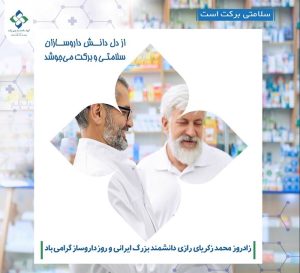
Self-medication in Iran: A rising health challenge|Need for better access & stricter drug regulations
Barekat Health & Pharmaceuticals Group: The trend toward self-medication and the overuse of anti-anxiety and painkillers is increasingly prominent in Iran’s public health landscape, raising significant concerns among researchers and policymakers from cultural, psychological, social, and economic perspectives.
In recent years, self-medication has especially become prevalent among the general public as a coping mechanism for psychological anxieties and social pressures. This trend contributes to serious concerns about mental and physical health in society.
The cultural roots of self-medication in Iran stem from multiple factors, including a lack of awareness about the risks associated with certain drugs, social and cultural pressure to manage stress independently, and the unrestricted access to non-prescription drugs at pharmacies.
While the misuse of anti-anxiety and pain medications is also a global concern, unique cultural factors in Iran make this issue particularly complex. Iranian cultural norms and social structures encourage self-medication, especially for stress and anxiety, with many individuals opting for sedatives without consulting healthcare providers. Cultural and psychological structures often lead people to self-medicate rather than seek professional help.
Self-medication in Iran is exacerbated by cultural taboos surrounding mental health. These include reluctance to see psychiatrists, an overemphasis on handling challenges independently, and a social stigma that discourages seeking mental health assistance. Consequently, many people turn to sedatives to cope with daily life pressures, creating a growing dependence on these medications.
Cultural Underpinnings of Self-Medication
In Iran and other cultures, self-medication is widely seen as a quick, economical solution to physical and mental issues. This tendency is deeply rooted in the long history of herbal remedies and traditional treatments in Iran, where people have traditionally sought home-based and personal solutions. This cultural heritage has embedded self-medication within the Iranian mindset.
Additionally, cultural beliefs that validate the use of anti-anxiety drugs as a legitimate way to relieve stress have fostered this trend. For example, individuals often feel pressured to appear resilient and in control of their problems, opting to self-medicate with tranquilizers rather than seeking professional mental health care. Cultural stigmas further reinforce the tendency to self-medicate rather than seek help from therapists.
Easy Access to Anti-Anxiety & Pain Medications
Furthermore, the lack of a robust oversight system for the distribution of sedatives and painkillers amplifies the problem. Pharmacies and online retailers frequently make these drugs available without adequate warnings of their side effects, encouraging more individuals to turn to self-medication.
Psychological & Social Implications of Self-Medication
Self-medication is a common response to everyday stressors and a coping mechanism underpinned by limited access to sustainable treatments. While this approach may offer temporary relief, it often leads to long-term issues, such as drug dependency and exacerbation of mental health conditions.
For some, these medications provide a fleeting sense of comfort and calm, and due to the psychological reinforcement of reduced anxiety, people are likely to continue and even escalate their usage. This habit can quickly spiral into psychological dependence and form a harmful cycle that becomes increasingly challenging to break.
Role of Education in Reducing Self-Medication
Public education and awareness efforts can play an essential role in reducing self-medication and the misuse of anti-anxiety and pain medications. If people understand the risks of improper drug use and recognize that these drugs should only be used under medical supervision, they may become less inclined to self-medicate.
Campaigns through media, social networks, and public health centers could help educate the public on the dangers of self-medication and the importance of professional mental health support. Establishing accessible counseling services at local health centers could also serve as an alternative to self-medication.
Social & Health Implications of Drug Overuse
The social and health consequences of excessive use of tranquilizers and anti-anxiety medications are substantial. On a social level, such behaviors lower overall quality of life, contribute to increased social and psychological dysfunction, and reduce productivity both at work and in the community. Overuse of sedatives and painkillers can also impair daily functioning and, in some cases, lead to risky behaviors.
On the health front, improper and excessive use of medications can lead to increased resistance, requiring higher doses for effectiveness and risking serious health problems like heart issues, neurological disorders, and even death. This cycle places additional strain on emergency services and public healthcare resources, which could be mitigated by limiting non-prescription drug access and promoting a culture of responsible healthcare.
Solutions for Combating Self-Medication
To address the self-medication trend, comprehensive programs aimed at increasing public awareness of drug misuse risks are essential. Such programs could include educational campaigns in the media, social initiatives, and curriculum additions in schools to inform younger generations about the dangers of self-medication.
Furthermore, strengthening prescription controls and enforcing stricter limits on non-prescription drug sales could curb excessive drug use. Improved access to affordable, high-quality counseling services could also encourage individuals to seek more sustainable, effective treatment methods.
Impact of Media & Advertising on Medication Trends
The influence of media and advertisements should not be underestimated. Many advertisements, directly or indirectly, emphasize the quick effectiveness of medications, which leads individuals to choose commercial drugs over longer-term treatment options. This issue is particularly prevalent among youth and those suffering from anxiety and stress.
Conclusion
-
Barkat Group specialized meeting

-
Safa Appointed as Barekat General Director

-
Barekat Health & Pharmaceutical Group at the 10th Iran Pharma Exhibition

-
Ali Safa visits Sobhan Oncology & Sobhan Darou

-
Pirsalehi & Safa visit Saman Daroo 8 Knowledge-based Company

-
Barekat Managing Director Visits Samen Pharmaceutical Company

-
Honoring Pharmacists’ Day

-
Barekat Top Executives Visiting to Barekat Hospital

